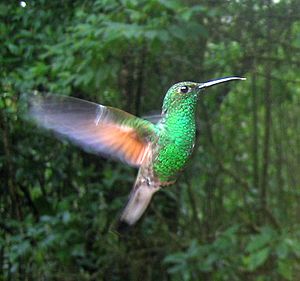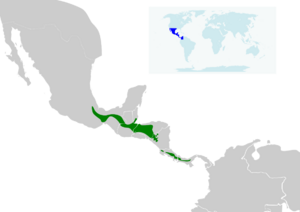Stripe-tailed hummingbird facts for kids
Quick facts for kids Stripe-tailed hummingbird |
|
|---|---|
 |
|
| Conservation status | |
| Scientific classification | |
| Genus: |
Eupherusa
|
| Species: |
eximia
|
 |
|
| Range of E. eximia | |
The stripe-tailed hummingbird (Eupherusa eximia) is a small, colorful bird. It is a type of hummingbird known for its quick movements and beautiful feathers. You can find this special bird living in areas from southeastern Mexico all the way down to Panama.
Contents
What is a Stripe-Tailed Hummingbird?
The stripe-tailed hummingbird is part of a group of hummingbirds called "emeralds." These birds are known for their bright, shiny green feathers. They are very small, usually measuring about 9 to 10.5 centimeters (about 3.5 to 4 inches) long. They weigh only about 4 to 4.5 grams, which is less than a nickel!
Different Kinds of Stripe-Tailed Hummingbirds
Just like people can have different hair colors or heights, animals can have different types within the same species. These are called subspecies. The stripe-tailed hummingbird has three main subspecies:
- E. e. eximia (the most common type)
- E. e. nelsoni
- E. e. egregia
Sometimes, other similar hummingbirds, like the white-tailed hummingbird and the Oaxaca hummingbird, are also thought to be part of this family.
How to Spot a Stripe-Tailed Hummingbird
Both male and female stripe-tailed hummingbirds have a straight, black beak. Their bodies are mostly bright, shiny green, like grass.
Male Hummingbirds
Male stripe-tailed hummingbirds have very bright, metallic green feathers on their backs. Their wings have a patch of cinnamon-red feathers that you can see when their wings are folded. The most interesting part is their tail! The inner tail feathers are dark bronze-green. The outer two pairs of tail feathers are black on the outside and white on the inside, with black tips. This gives them their special "stripe-tailed" name. Their bellies are also bright metallic green.
Female Hummingbirds
Female stripe-tailed hummingbirds also have green feathers on their backs. Their bellies are more brownish-gray, with metallic green spots on their sides. Their tails are similar to the males', but the inner feathers might have dusky or black tips.
Differences in Subspecies
- E. e. nelsoni males are a bit bigger than the common type. Their bellies are more yellowish-green, and the black tips on their outer tail feathers are not as clear.
- E. e. egregia males are also larger. The black on the outer tail feathers is only at the very tip. Females of this type often have outer tail feathers that are completely white.
Where Do Stripe-Tailed Hummingbirds Live?
These hummingbirds live in different parts of Central America.
- The E. e. nelsoni subspecies lives in the northernmost areas, in eastern Mexico (Veracruz and Oaxaca).
- The E. e. eximia subspecies is found from extreme eastern Mexico (Chiapas) south through southern Belize, Honduras, and El Salvador, reaching central Nicaragua.
- The E. e. egregia subspecies lives in Costa Rica and western Panama.
These birds prefer to live in humid forests, especially in the mountains. They can also be found in forests that lose some leaves in dry seasons, pine-oak forests, and even on plantations. They live at different heights, from near sea level up to about 2,450 meters (about 8,000 feet) high in the mountains.
Behavior and Life Cycle
How They Move Around
Stripe-tailed hummingbirds often move to different elevations depending on the season. They usually breed in the higher parts of the mountains and then move to lower areas after their breeding season is over.
What They Eat
Stripe-tailed hummingbirds mostly eat nectar from flowers. They can be seen looking for food at all levels of the forest, but they especially like to feed high up in the treetops. When they are at the edges of forests or in clearings, they might feed lower down. Male hummingbirds are quite protective and will often chase away other birds from their favorite patches of flowers. They enjoy nectar from many different plants, including Inga trees, Acanthaceae and Rubiaceae shrubs, and flowers from plants like Clusia, Besleria, and Salvia.
Reproduction and Nests
Stripe-tailed hummingbirds have different breeding seasons depending on where they live. In Mexico, they breed from April to August. In Costa Rica, their breeding season is from September to April. They build a small, cup-shaped nest using soft plant fibers. They often decorate the outside of the nest with lichens, especially red ones. These nests are usually placed about 1 to 3 meters (about 3 to 10 feet) above the ground, often near a stream. A female hummingbird usually lays two eggs. We don't know exactly how long it takes for the eggs to hatch or for the baby birds to be ready to fly.
Their Calls and Songs
The stripe-tailed hummingbird has a unique song. It sounds like "1-3 squeaky, sometimes metallic notes, then a low, dry, insectlike trill, then 1-3 more squeaks." They also make different calls, like a "liquid, rattling trill," a "sharp, piercing peet or bzeet", and a "sharp buzz."
Status of the Stripe-Tailed Hummingbird
The IUCN (International Union for Conservation of Nature) has looked at the stripe-tailed hummingbird and decided it is a species of "Least Concern." This means that, for now, there isn't a big worry about them disappearing. We don't know exactly how many of them there are or if their numbers are changing, but they are considered fairly common in most of the places they live. However, they could be at risk if their forest homes are destroyed, especially in southern Mexico.


